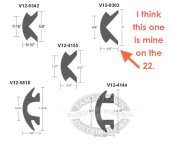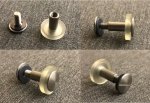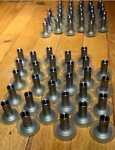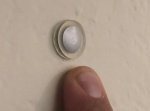Kushtaka":3s1hm3ir said:
So there is a youtube video of someone selling a CDory 22:
https://www.youtube.com/watch?v=wCIjkHzEEgU
He is trying to sell his C-Dory, but starts out telling people he will tell them all the things to look out for if they are shopping for a used CD. The first thing he does after that is talk about the blobs cracking, and how that is very bad, and an issue to watch out for.
That sounds like member "Flagold's" video. He's an accomplished boatman (and more), and makes some good videos. He did a lot of neat stuff with his 22 :thup
Kushtaka":3s1hm3ir said:
I happen to disagree with the idea that cracked "blobs" are and issue to be concerned about. I must be, because most of mine are cracked, and it does not matter one bit. Water never comes in, nothing comes of it.
On my boat, when I started repairing some of the rivets, I noticed that the ones that were broken/failed were pretty much the ones that corresponded with crack(s) on the inside, gelcoated-over caulk blobs. So my guess is that it is often a sign of rivet failure, or perhaps weakened rivets that have not failed yet. The cracks indicate some movement (gelcoat over a "soft" surface, so not a big surprise that it would crack anyway).
Kushtaka":3s1hm3ir said:
Is this relevant to years other than mine (1993), or is it a bunch of nonsense? If so, there is some mis-info out there that may be driving down the value of our boats!
I don't know how a 1993 was put together. The boats in later years (although I think not those built in the last year or so, although I don't have the exact details) have an aluminum rubrail, put on with aluminum pop rivets that seem as though they might have had steel mandrels (not sure, but the corrosion seemed to indicate the possibility of dissimilar metals, and some of the mandrels were VERY tough and not aluminum like). Then to "finish" the inside, a blob of caulking (polysulfide on my boat, from what I can tell) was put over the rivet end, and gelcoat sprayed into the hull. For various reasons (dissimilar metals, lots of strain on a thin, aluminum rivet tube, water that sits in the low point amidships, etc.) the rivets seem to fail after a number of years. Perhaps your 1993 is put together differently.
Since there is no core in the way of the rivets or rubrail, it's not like a "secret" failure is going to cause a sneaky problem that builds without one knowing it. Eventually the rubrail will pull away, and/or there will be a leak, or ... it won't. One can fix it prophylactically, fix it after they see some symptoms, or just leave it. A certain amount of leakage will just stop at "the blob," most likely. I never had any leaks, but then the rail pulled away and the broken rivets left visible holes, so... I would have had leaks had I not fixed them.
The satisfying thing (to me) is that it's one of those jobs where it truly is "better than new" when you get done - and it's pretty manageable. That said, it's something that's nice to know about if you are boat shopping, especially if you don't want to tackle it, and/or would just like to know about it. I often go into a boat or other purchase with the attitude of "I don't mind problems but I prefer not to have surprises," so I'm one who likes to know what I'm looking at.
Since all the C-Dorys I know of are built similiarly, I don't see it driving down the value (although it might increase the value of the very newest boats that are put together differently from what I have heard). I haven't found a production boat yet that doesn't have similar issues, so I don't really see it changing the value as compared to other boats. If you want a C-Dory, you simply deal with its specific issues as they come up (as opposed to the specific issues of another brand/model of boat - and it will have them!).
That's my feeling anyway.






